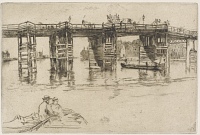Etchings Institutions search term: caxton club
Old Putney Bridge | ||
| Number: | 185 | |
| Date: | 1879 | |
| Medium: | etching and drypoint | |
| Size: | 200 x 298 mm | |
| Signed: | butterfly at bottom (1-5); shaded (6-final) | |
| Inscribed: | no | |
| Set/Publication: | Fine Art Society, 1879 | |
| No. of States: | 7 | |
| Known impressions: | 47 | |
| Catalogues: | K.178; M.175; W.145 | |
| Impressions taken from this plate (47) | ||
KEYWORD
TITLE
'Old Putney Bridge' (1879, R.A.). 2
'Putney Bridge' (1879, Grosvenor Gallery). 3
'Old Putney Bridge' (1879, Whistler). 4
'Putney Bridge' (1887, Whistler). 5
'Putney Bridge' (1886, Frederick Wedmore (1844-1921)). 6
'Old Putney Bridge' (1909, Howard Mansfield (1849-1938)). 7
The title 'Old Putney Bridge' distinguishes it from the two smaller views of Putney, Little Putney Bridge [186], and The Little Putney [187]. The title presumably refers to the age of the structure, because there was at that time no 'new' bridge.
2: London RA 1879 (cat. no. 1233).
3: London Grosvenor 1879 (cat. no. 285).
5: List, [August 1887/1888], GUW #13233.
6: Wedmore 1886 A (cat. no. 145).
7: Mansfield 1909 (cat. no. 175).
DESCRIPTION
8: ibid.
SITE
Putney Bridge was a good site for viewing the sculling and boat racing on the Thames, including the University Boat Race, which took place between Putney and Mortlake in April. The river was much cleaner than in the East End, or around the Pool of London, and a Times correspondent noted: 'wonderful accounts of fish being caught at London-bridge, Putney, &c., consequent on the improved condition of the water since the sewage has been carried to Crossness and Barking Reach.' 9
9: John Bartlett, to the Editor, 22 October 1879, 'Pollution of the Thames', The Times, London, 23 October 1879, p. 7.
DISCUSSION
10: Huish to Whistler, 14 March 1879, GUW #01098.

